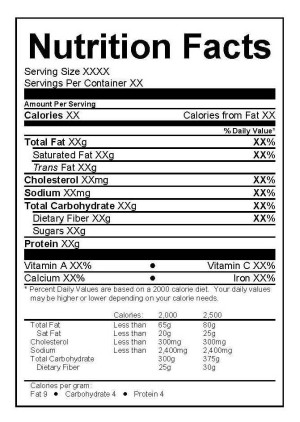
R. FLORA & ASSOCIATES
Food Labeling Guidelines
What follows is a summary of the basic requirements for mandatory information on conventional food labels. This is a great starting point for setting up and checking your labels, but the actual regulations contain far more detail and should be consulted whenever you are preparing or reviewing labels for your conventional food products.
Whenever you have questions about labels and labeling, R. FLORA & ASSOCIATES is here to help you. With our vast experience in label preparation and review, there are few questions that we cannot answer.
PRINCIPAL DISPLAY PANEL (PDP)
The following information must appear on the principal display panel.
The minimum allowable type size is 1/16" in height (unless exempted or otherwise specified).
Product Name
Statement of Identity
The statement of identity should either be included in the name of the product or should follow the product name in letters reasonably related to the most prominent print on the principal display panel in lines generally parallel to the base of the package. FDA and several states have expressed their position that "reasonably related to the most prominent print" means that the height of the type is not less than half the height of the largest print on the panel.
Net Quantity of Contents Declaration
Except for containers with a PDP of 5 square inches or less, the net quantity of contents declaration should appear on the lower 30% of the principal display panel in lines generally parallel to
the base of the package. The net quantity of contents declaration may appear anywhere on the PDP of containers with a PDP of 5 square inches or less as long as all of the other requirements are
met.
There must be adequate space between the net contents declaration and other printed label information. The space between the net contents declaration and any other information printed above or
below shall be at least the height of the lettering used in the net contents declaration. The space to the right or the left shall be at least twice the width of the letter "N" of the style of
type used in the net contents declaration.
The type size requirements for the net contents declaration vary with the area of the principal display panel. They are as follows:
Area of Principal Display Panel Minimum Type Size
5 square inches or
less
1/16"
More than 5, but not more than 25 sq. in. 1/8"
More than 25, but not more than 100 sq. in. 3/16"
More than 100, but not more than 400 sq. in. 1/4"
More than 400 square inches 1/2"
If lower case, or both upper and lower case letters are used, the lower case letter "o" shall meet the minimum type size requirement.
The statement of net contents must appear in both the English (inch-pound) system and the metric (SI) system. Either the English or metric units may be listed first, however, whichever units
are second should be in parentheses.
INFORMATION PANEL (IP)
The following information must either appear on the information panel, together in one place, with no intervening non-mandatory information, or on the principal display panel.
There are special type size requirements for the information in the “Nutrition Facts” box. The minimum allowable type size for all other mandatory information is 1/16" in height (unless otherwise exempted).
Nutrition Information
The following is an example of the typical “Nutrition Facts” box, formatted in compliance with the current regulations:
There are specific requirements regarding what information is mandatory in the “Nutrition Facts” box and what may be voluntarily included.
There are both requirements and recommendations for the graphic enhancements of the “Nutrition Facts” box. A number of variations and exemptions are permitted, depending on the situation.
Ingredients Statement
The ingredients that make up the food must be listed by common or usual name, in descending order of predominance by weight, after the heading “Ingredients:” Ingredients present in amounts of 2% or less are not required to be in order provided they are listed under the heading "Contains 2% or less of..." and the heading follows the last ingredient that is over 2%. A threshold of 1.5%, 1.0%, or 0.5% may be used in place of 2%, as long as none of the ingredients following the heading exceed the threshold.
The ingredients list must include all ingredients in the product including excipients, colors, flavors, preservatives (which must be further identified as preservatives), etc. There are specific allowances and/or requirements for listing spices, flavors, colors, and preservatives. There are also specific allowances and/or requirements for listing skim milk, milk, bacterial cultures, sweetcream buttermilk, whey, cream, butteroil, dried whole eggs, dried egg whites, fats and oils, wheat flour, leavening agents, yeast nutrients, dough conditioners, firming agents, sugar, wax and resin ingredients on fresh produce, processed seafood products containing fish protein ingredients, water, and "nondairy" ingredients.
Name and Place of Business Declaration
The label must include the name and place of business of either the manufacturer, packer, or distributor.
The place of business statement must include the street address, city, State, and Zip Code. However, the street address is not required on the label if it is listed in current city directory or telephone directory. The P.O. box may be included, but it is not an acceptable substitute for the requirement to include the street address.
If the food is not manufactured by the company whose name appears on the label, the name must be qualified by a phrase that reveals the connection such person has with the food; such as "Manufactured for _______", "Distributed by _______", or any other wording that expresses the facts.
Warning Statements when specified by regulation
There are no general warning statements that apply to all foods, but there are specific warning statements that apply to specific foods. Most can be found in 21 CFR §101.17 which contains warnings for:
- Foods packaged in self-pressurized containers
- Foods packaged in self-pressurized containers with halocarbon or hydrocarbon propellants
- Foods containing or manufactured with chlorofluorocarbon or other ozone-depleting substances
- Protein products that derive more than 50% of their caloric value from protein, protein hydrolysates, and/or amino acids
- Dietary supplements containing iron or iron salts
- Foods containing psyllium husks
- Juices that have not been specifically processed to prevent, reduce, or eliminate the presence of pathogens
- Shell eggs
Specific warnings, such as the warning required for foods containing aspartame, may be found in the food additive regulations.
Individual states may require specific warnings such as the warning required by the State of California for products containing certain laxative containing botanical ingredients and the warnings required by California under Proposition 65.
When Certain Types of Claims are Made
There are additional labeling requirements when certain types of claims are made.
Nutrient Content Claims
These are claims that characterize the level of a nutrient in the food. Only claims specified by regulation or compliant with the FDA Modernization Act (FDAMA) are allowed. The claims specified by regulation are found at 21 CFR §101.13 and at 21 CFR Part 101 Subpart D. The claims compliant with FDAMA may be found on FDA's website.
There are type size and placement requirements for nutrient content claims.
If the level of fat, saturated fat, cholesterol, and/or sodium exceeds certain amounts, a disclosure statement is required. There are type size and placement requirements for the disclosure statement.
Health Claims
These are claims that characterize the relationship between a food, or a component of the food, to a disease or health-related condition. Three types of health claims are allowed:
- Authorized Health Claims - claims authorized by regulation through the rule-making process. These claims must meet significant scientific agreement (SSA).
- FDAMA Claims - claims based on authoritive statements made by federal scientific bodies. These claims may meet less that SSA but must come from a federal scientific body (e.g., NIH, CDC, etc.).
- Qualified Health Claims - claims resulting from Pearson v. Shalala. These claims are based on data suggesting a relationship, but meeting less than SSA.
Authorized Health Claims may be found at 21 CFR §101.14 and at 21 CFR Part 101 Subpart E. The claims compliant with FDAMA may be found on FDA's website. The Qualified Health Claims may be found elsewhere on FDA's website.
All information required to be in a health claim must appear in one place without other intervening material, except that the PDP of the label or labeling may bear the reference statement, "See _____ for information about the relationship between _____ and _____" (with the blanks filled in with the location of the labeling containing the health claim, the name of the substance, and the disease or health-related condition) when the entire health claim appears elsewhere on the label or other labeling (e.g., "See attached pamphlet for information about calcium and osteoporosis.").
When a health claim is made on the label of a food that is based on the reference amount customarily consumed and the labeled serving size differs from that amount, the claim must be followed by a statement explaining that the claim is based on the RACC rather than the labeled serving size (e.g., "Diets low in sodium may reduce the risk of high blood pressure, a disease associated with many factors. A serving of ____ ounces of this product conforms to such a diet.").
Statements of Support
Statements of support, also known as structure/function claims, describe the role of a nutrient or dietary ingredient intended to affect normal structure or function in humans, for example, "calcium builds strong bones." In addition, they may characterize the means by which a nutrient or dietary ingredient acts to maintain such structure or function, for example, "fiber maintains bowel regularity," or "antioxidants maintain cell integrity," or they may describe general well-being from consumption of a nutrient or food. Statements of support may also describe a benefit related to a nutrient deficiency disease (like vitamin C and scurvy), as long as the statement also tells how widespread such a disease is in the United States.
Statements of support may be made for conventional foods as long as they are truthful and non-misleading and are based upon the nutritive value of the food or substance in the food.
There are no type size or placement requirements for this type of claim other than the claim(s) may not intervene within mandatory information that is required to appear in one place on the information panel.


